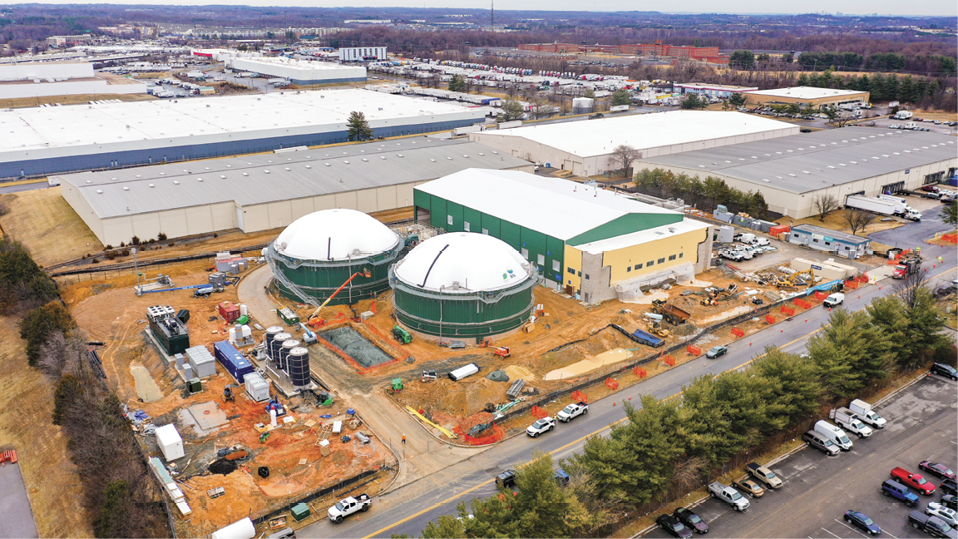
As more traditional methods of waste disposal such as landfilling and incineration fall from favor—either because of shrinking capacity or legislative pushes for better waste management practices—anaerobic digestion (AD) and composting have become growing topics of conversation.
Creating a host of products, including soil amendments, animal feed and renewable energy, the processing methods—sometimes in tandem—are no doubt more sustainable solutions.
In a webinar hosted by the Northeast Recycling Council (NERC), Brattleboro, Vermont, and the Northeast Waste Management Officials’ Association (NEWMOA), Boston, titled Anaerobic Digestion Facilities: Operators’ Perspectives on Siting and More, panelists shared details about their AD facilities and how they’re working to divert food waste.
In rural Maine, Holden Cookson, director of business development for Agri-Cycle Energy, said his company has had no problem obtaining the needed feedstock for its anaerobic digester, which takes in roughly 300 tons of food waste each day.
Using a fleet of collection trucks, 53-foot box trailers, live-load trailers and roll-off trailers, Agri-Cycle collects food waste from residences, restaurants, grocery stores, institutions, processors and manufacturers. When approaching a new client, Cookson said the company’s core service is collecting food waste for processing, even if it’s not suitable for AD.
“Coffee grounds and shells [are] not best for anaerobic digestion, but we will still use our hauling infrastructure to find a market for it, either by bringing it to our own facility or finding a local use,” he said.
Tackling contamination
Contamination was a common thread amongst panelists, who shared the importance of preprocessing and source separation to ensure a clean mix.
“Do as much [as possible] at the feed source before taking in materials,” said Brian Paganini, vice president and managing director of Southington, Connecticut-based Quantum Biopower. He added that loads should be inspected before committing to a stream long term.
Andrew Cassilly, vice president of governmental relations at Annapolis, Maryland-based Bioenergy Devco, said his company follows similar procedures, using scales and data to find sources of contamination.
“We know the time, date and driver to identify accidental or sometimes purposeful contamination,” he said.
Because of the large swaths of material a facility can receive, panelists agreed having both AD and composting infrastructure can be beneficial.
“We started out as composters [and] worked our way into digestion,” Paganini said. “We see it as another tool in the tool belt to be able to recycle materials not suited for digestion, like high-nitrogen feedstocks that can create toxicity in the AD process.”
Agri-Cycle, which also has a composting facility in North Hartland, Vermont, said single-serving products and their packaging have made it difficult when most facilities require source separation and have different tolerances for contamination.
“Outcomes of either process have their place and are equally as necessary,” Cookson said.
He credited processors like Quantum Biopower and Bioenergy Devco with helping to manage the high volumes of food waste in the Northeast, noting that working with companies that have like-minded ideals and similar infrastructure can make the job easier.
“The unfortunate reality is there’s enough to go around. … We collect about 300 tons daily, and that’s even with our programs being intentionally designed to highlight the hierarchy and importance of the food waste scale,” Cookson said.
Being accessible
To position itself as a safety net for beneficial use through prevention, reduction and recycling, Cookson said Agri-Cycle prioritizes proactive programming, using scorecards, quarterly surveys and standard signage to educate participants. Each facility serviced receives a standard operating procedure, which breaks down what service they’ll receive, service frequency and signage and resources to aid the process.
Cookson emphasized the importance of accessibility throughout the process, highlighting the need for regular updates, using tools like QR codes and having materials in multiple languages.
Clients also receive access to a database of online resources, including a food donation database network and educational materials as well as current policy and sustainability news.
“Our programs are intentionally designed to highlight the hierarchy of the food waste scale,” he said.
Critical infrastructure
Similar to Agri-Cycle, Quantum Biopower operates a composting facility and depackaging plant alongside its digester.
Constructed in 2015, Quantum Biopower’s digester takes in roughly 40,000 tons of food waste per year. Methane produced at the facility powers a combined heat and power system, which creates electricity and hot water for utilities such as Eversource and the town of Southington, where Quantum Biopower’s campus is located. Meanwhile, residuals are blended with other organic materials to create compost.
Since 2017, the digester has helped to recycle 110,000 tons of food waste. Paganini said obtaining a permit for the company’s facilities was a difficult process that took roughly two years. Once the facility was permitted, it took Quantum Biopower 12 months to build and 12 months to commission.
Operating on less than 1 acre, the facility is vertically constructed to ensure efficient process flow. Given the digester’s compact footprint, Paganini said noise and odor control were primary concerns.
“Operators are what separate good [facilities] from great facilities,” Paganini said. “[We] spend a great deal of time organizing, cleaning and training. It’s really critical. It separates successful operations from [those that are] not successful.”

Explore the May/June 2024 Issue
Check out more from this issue and find your next story to read.
Latest from Waste Today
- Veolia completes PFAS waste incineration testing
- WM names company president
- New Way recognizes top distributors
- BTR launches redesigned website
- WasteExpo 2025: EPR implementation requires collaboration, harmonization
- GP to shutter containerboard mill in Georgia
- SmithCo adds director of manufacturing
- ROTAC® Tippers: Made to lift





